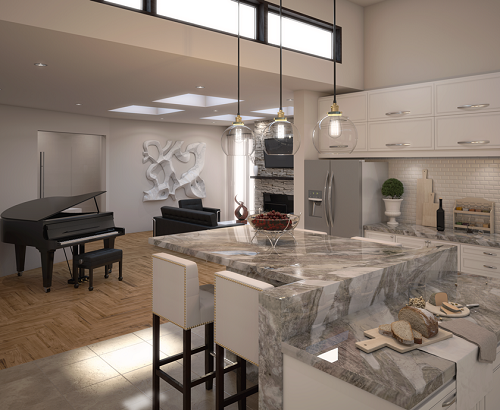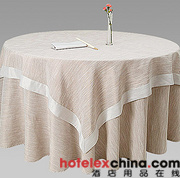
Imagine if before you ever swung a hammer on the jobsite, your clients could experience their remodeled space—not just see pictures, but stand in it, look at it from all angles, walk through it. Thanks to the quickly expanding field of virtual reality (VR), that possibility no longer has to be relegated to your imagination.
The popularity of virtual reality devices has skyrocketed since their introduction to the market. A Jan. 3 report from the Consumer Technology Association predicts VR headset unit sales will reach 2.5 million units (a 79% increase) and $660 million in revenues (a 43% increase) in 2017. Industries from gaming to real estate development are getting on board with the new tech revolution—and remodeling doesn’t look to be far behind.
A photo-real rendering by virtual modeling software company Invent Dev
Invent Dev
A photo-real rendering by virtual modeling software company Invent Dev
Taking a Test Drive
At Bethesda, Md.-based Case Design/Remodeling, designers have been working with virtual reality tools for about six months, with Oculus Rift headsets available at the company’s Bethesda and Falls Church, Va., locations.
Case Design/Remodeling made the decision to begin offering virtual reality capabilities as another value-added option for its clients, particularly those who are undertaking major projects that involve a significant redesign. “For those projects, we were creating the 3D models anyway, so this isn’t too much more work, and it’s a benefit to be able to show this to the client,” says director of design Ellen Linstead Whitmore.
Virtual reality, she says, helps provide reassurance to clients about their project as they are able to truly visualize and experience the space before work begins.
“As designers, we’re able to visualize things pretty easily, but sometimes it’s harder for the homeowner,” she explains. While images can certainly help in this regard, they lack the immersive quality that VR brings to the table.
The firm has been rolling out the relatively new technology gradually since its debut, and so far, the feedback has been overwhelmingly positive—even from the more skeptical clients, Whitmore says. “They’ll see me demo it and watch what I’m doing on the screen and think, ‘Oh I get it, I understand.’ And I’ll say, ‘No, put on [the headset] and see.’ And the reaction is always, ‘Wow.’”
In a visit to Case’s Bethesda showroom, I was able to put on the headset and try the technology for myself (not being an avid tech lover, this was my first encounter with virtual reality) and can vouch for the truth behind Whitmore’s words. The experience was impressive and sometimes even a bit unnerving—as Whitmore talked to me about what I was seeing, I’d turn my head to look at her and be thrown not to see her standing next to me in the virtual scene.
One of the models Whitmore showed me during my visit was from a recent remodel where VR proved to be an invaluable tool for the homeowners. They had first imagined their narrow kitchen in a galley style, with cabinets on one wall and a breakfast bar on the other. Upon seeing the layout created in the virtual environment, they decided that it wasn’t what they wanted and opted to switch the configuration to include a large island in the center of the space instead, Whitmore explains.
“It’s a test drive,” she says. “It’s the closest you can get to actually being in your new space, and I think it is the future.”
Options Aplenty
The good news for remodelers interested in exploring virtual reality technology is that the rapid rise in popularity means there are more offerings than ever to choose from. Rather than having to pick from only a few options, remodelers can now find a solution to fit their needs and budget.
One key in making that possible has been the growth of mobile VR products, which deliver slightly reduced virtual reality capabilities at a much lower price point. Unlike Oculus Rift and other similar systems, mobile VR requires only a smartphone and a virtual reality viewer; portable headsets are available for purchase online starting around $15.
A demo of Invent Dev's new mobile VR tool at the International Builders' Show
Invent Dev
A demo of Invent Dev's new mobile VR tool at the International Builders' Show
Toronto, Ontario-based Invent Dev, a developer of 3D and virtual reality software, originally focused on building virtual model homes for big builders, but smaller builders and remodelers are the target audience for its newest product: a design tool compatible with mobile VR capabilities.
“One of the advantages of mobile virtual reality is that it is very accessible; it’s easy to share,” says CEO David Payne. He notes that the two capabilities serve different purposes: Tethered VR provides a more immersive experience but is limited to one location, such as a showroom or office, while mobile VR can be shared with clients at their home or on a jobsite.
Invent Dev’s “conceptual creative tool,” as Payne describes it, allows users to quickly draw floor plans, apply finishes, and create a 3D environment that can be shared with clients as a virtual reality experience. “At any point in time they can always switch into virtual reality mode … so it’s very dynamic.”
Another mobile VR product making waves in the industry is from Irving, Texas-based Biorev, which won Best of IBS honors for best home technology product at the show in January. Bio-rev’s application is designed to be a more affordable VR option for construction pros, says Sagar Gupta, executive vice president of design and digital marketing. “Technology should be accessible for everyone; it should not be a luxury.”
Biorev offers a multi-platform tool that can be used with mobile headsets or directly on a smartphone or tablet, should a client be reluctant or unable to use the VR functionality, Gupta says. “Clients really like the multi-platform compatibility offered, so they have the freedom of choosing,” he adds. “Anywhere you want to showcase it, you are ready.”
Mobile VR provider Biorev binocular rendering technology to bring renderings like this one to life
Biorev
Mobile VR provider Biorev binocular rendering technology to bring renderings like this one to life
To use the app, customers send Biorev CAD files or drawings that the company uses to create a 3D environment. Clients can also send an interior package or choose from one of Biorev’s seven templates to populate the space, Gupta explains. The turnaround time is about a week to 10 days.
Meanwhile, long-time player in the BIM and 3D modeling field Cadsoft is also expanding its VR options. The company, headquartered in Guelph, Ontario, began offering Oculus Rift and HTC Vive compatible programs last year, and this year at IBS introduced its newest app to be used with mobile headsets, says director of customer service Chantale Pitts.
From its suite of software products, Cadsoft specifically recommends Building Essentials for remodelers; the offering provides a streamlined operations hub for their business, says Pitts. The system creates an intelligent model, so “it does the counting for their estimates, creates that virtual reality space so they can immerse the client, and creates the working drawings as well,” she says. “It speeds up the whole process and allows them to flesh out their design.”
An Immense Upside
As virtual reality continues to grow in the commercial realm, it’s likely that more consumers will look for this technology in the home improvement field as well, so remodelers would be wise to educate themselves now.
Though the construction industry traditionally has been slow to adopt new technology, Gupta says, that is beginning to change. “There was a certain section of the construction industry that ignored the power of technology. A few of them understood it, but it was [too] expensive,” he says. But since his company entered the construction domain two and half years ago, he adds, “builders have been really fascinated.”
Cadsoft's technology combines the back-end technology of BIM with the presentation capabilities of virtual reality
Cadsoft
Cadsoft's technology combines the back-end technology of BIM with the presentation capabilities of virtual reality
And though some remodelers who aren’t as tech-savvy might be wary of the learning curve, Pitts says those concerns can be put to rest. “Technology in the last five years has really just taken off and is making everything simpler and easier to use, so that there isn’t that fear factor anymore.” She adds that Cadsoft offers a variety of options, from blogs to webinars to in-person training, to help clients learn the software.
No matter which of the many VR options remodelers ultimately choose, developers are bullish about the benefits.
“Images and videos give a very limited perspective,” says Payne. “[With virtual reality], you feel like you are actually inside the space: You can walk around, you can look around, you can look over and under things, much like you would in the real world.”
Pitts agrees. “The immediate reaction is strong,” she says. “[Users] feel like they’re in the space, like they’re walking inside their home, and there is a wow factor for them.”
That immersive experience comes with a variety of benefits for both the pro and the consumer, Payne says. “What [VR] does is it really eliminates doubt, misunderstandings, and stress throughout the process,” he explains. “It’s not only to win more clients and not only to increase sales and sales conversions and upgrades—those are all benefits—but it’s also more about the actual experience itself. To have clients say, ‘I worked with this builder and throughout the entire process I had no concerns.’”



Service Hotline
Work Time:Mon-Fri 9:00-18:00
UTC+8

Sinoexpo Digital Platform
Copyright 2006-2025 Shanghai Sinoexpo Informa Markets International Exhibition Co., Ltd. All rights reserved
沪ICP备05034851号-77
 沪公网安备 31010402000543号
沪公网安备 31010402000543号